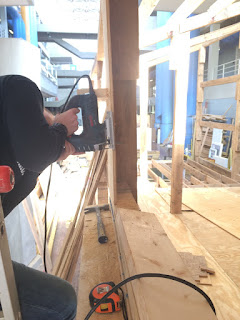We have one more building mockup completed! This time we’re looking at how the green oak
cants can be used as siding on a building.
With this 1:1 scale mockup, we’re investigating the weathering capabilities
of 5/8” thick boards and the fasteners that are used to attach them. This mockup will use stainless steel screws
as well as typical woods screws to get a better idea how the acid in the oak
will corrode the different metals. We
will evaluate the structure periodically to look at how ‘fissures’ or cracks
may occur along the fastener point where the boards are pinned.
A roughly 4”x6” cant can be milled into 6 boards. We
purchased ours cants from United Forrest Products in Morristown, Tennessee,
they also milled them down for us. The
great folks were a big help in cutting a small order like ours (48
boards), I think they’re used to cutting quantities like 4,800!
The initial idea for this mockup was a 4x4x8’ box that would
be clad in oak boards, using a pattern called reverse board and batten. The box allows us to simulate the proper air
space behind the boards that we would expect in the final project. The air space is critical as this allows moisture
to leave the boards easier after a rain.
We re-purposed two floor panels that were used in the
original green oak exhibit; those 2”x6”s frames are beefy!
No, Oliver isn't parkouring, he’s fastening in a lot of
extra cross bracing. We decided to build
most of the structure inside the Art + Architecture building for the ease of
construction and access to the woodshop. It’s too bad that not all construction sites have air conditioning!
No this isn’t a port-a-john! It is the pre-oak-sided box
frame being lowered with the help of a UT motorpool truck and its tremendously
helpful lift gate. Just the frame alone
probably weighs a little more than three hundred pounds, didn’t I say those 2”x6”’s
were beefy! No problem with five architecture students eager to get their hands
dirty!
You can see the house wrap that covers the box. This is because we wanted to be true to the
wall design and prevent water from escaping into the plywood covered frame. Those 2”x3”s and 2”x4’s you see are called
furring strips, in our case, we over sided them to allow us hang the very heavy
oak siding without concern.
Hey it’s looking good!
We've got the boards spaced appropriately and Oliver is putting his finishing
touches on the roof. Why a roof? Well, want to keep the inside dry.
And it’s done!! Yes, it may look like an over glorified outhouse but we have bigger plans. We
expect to monitor this mockup over the next three months. We’re happy to get it up this time in the year
where it’ll be experiencing a wide range of temperature changes and precipitation.
-Paul Attea




























